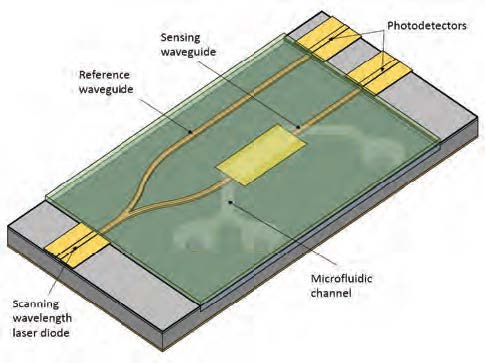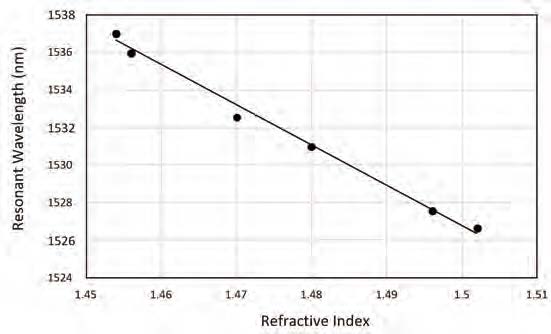Highly portable compact integrated sensors that are capable of fast response times are very attractive and in great demand for many applications in the medical field as well as for homeland security purposes. In order to have sensor modules that are fully integrated on-chip, it is imperative that both active and passive devices be compatible and easily implemented using conventional device fabrication techniques. Such devices include among others, a broad spectrum continuously scanning laser diode, an integrated photodetector, and an optical waveguide integrated sensor, as well as a compatible system for microfluidic channels.
At CREOL, we have been working on a highly effective scheme that consists of monolithically integrated tunable laser and photodetectors that are fabricated on semiconductor epitaxial layers grown on a single substrate. The other components are fabricated in silicon nitride and/or silicon oxynitride platforms that are grown by plasma enhanced chemical vapor deposition (PECVD). The sensor waveguides are surface plasmon resonance (SPR) inverted rib waveguides that are fabricated using a highly stable epoxy (SU-8). Finally, the microfluidic channels are patterned in a polydimethylsiloxane (PDMS) silicone membrane that is fitted on top of the waveguide structure.



The principle of operation is as follows: a liquid with suspected contaminants is passed through a microfluidic channel to the gold sensing surface that has been prepped to accept only a specific contaminant. When the contaminants attach to the sensing metal, the effective index of the plasmonic waveguide and its SPR wavelength are altered. By measuring the relative transmission of the waveguides while scanning the laser wavelength, a quantitative analysis of the concentration of the detected contaminant is obtained after several successive scans.
First, the tunable laser and the photodetectors are fabricated on the semiconductor epitaxial structure. The two photodetectors are p-i-n waveguide photodiodes that absorb practically all of the photons that pass through the reference and sensing waveguides respectively. By employing two identical photodiodes, differential signal monitoring yields very sensitive measurements that are also fairly insensitive to environmental changes that the device may be subjected to. The tunable laser diode is a multiple-section single-stripe semiconductor quantum-well laser in which the sections have been modified in a post-growth selective area intermixing process to yield different optical bandgap energies. By injecting varying currents in the separate sections the lasing wavelength can be controlled finely over a broad range of wavelength. This allows for the scanning of the wavelength of the probing light source for monitoring the SPR wavelength.
The section between the laser and the photodetectors are etched off and the passive components are fabricated in PECVD grown silicon dioxide and/or silicon oxynitride. First, a layer of silicon oxynitride is deposited on the substrate. Channels that will eventually form optical waveguides are delineated in the silicon oxynitride film by photolithography and reactive ion etching. The surface is spin-coated with a thin layer of a SU-8 epoxy that fills out the etched-out channels forming inverted rib waveguides with a top surface that is totally flat, and therefore is ideally suited for coating with a very thin layer of gold sensing film. The top PDMS membrane has an etched groove through which fluids can be pumped over the sensing membrane. First, a solution containing an activating enzyme agent is flowed through the channel, that coats the gold surface with a layer of biomolecular recognition element. Then, a solution containing the test sample is flowed through. If the target analyte is present in that solution, these molecules will lock onto the coated gold surface. While scanning the wavelength of the laser, a change in the surface plasmon resonance wavelength is readily detected.
An array of sensors can easily be integrated that can efficiently rule out or detect the presence of a large assortment of suspected biomolecular agents in the solution. With simply modifications such scheme can also be used for detection of gases and gaseous agents.
Author

Professor Patrick LiKamWa has been with CREOL since 1989. His research interests include optoelectronics and integrated optics devices. This work is a collaboration with Professor Hyoung Jin (Joe) Cho in the Department of Mechanical and Aerospace Engineering at UCF.